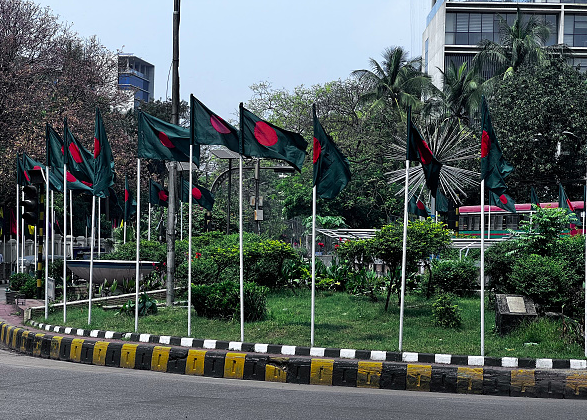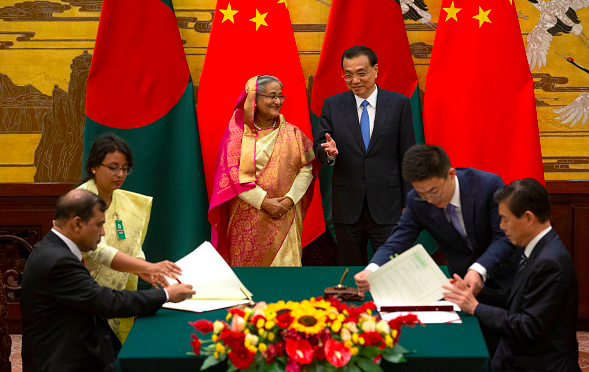
Analysts have increasingly touted the strategic importance of the Indian Ocean Region, calling the 21st century a maritime century and the ‘Indo-Pacific era.’ Devising Indo-Pacific strategies has become a standard policy practice, first introduced by the United States and later by its allies and partners such as Japan, Australia, and the United Kingdom (UK). For states on the Indian Ocean’s littorals, however, the Indo-Pacific is but a new framing for a longstanding strategic outlook.
Bangladesh’s location on the Bay of Bengal places Dhaka at the center of Indo-Pacific debates. In recent years, Bangladesh has received geopolitical attention for its unfettered access to the Bay of Bengal. In response, Bangladesh has taken a bold step in broadening its strategic outlook from land-centric to maritime, where the Bay of Bengal stands as its ‘third neighbor,’ which shows Bangladesh’s recognition and commitment to the Indo-Pacific.
However, as Bangladesh has stepped into its position as an Indo-Pacific player, experts in capitals abroad continue to view Dhaka’s foreign policy through a geopolitical lens. Bangladesh has chosen to stand as a regional leader, not a party to bloc politics. This framing is essential to understanding Dhaka’s forthcoming Indo-Pacific Outlook.
Bangladesh & the Indo-Pacific
There has yet to be a consensus on what geographies constitute the Indo-Pacific. Instead, Indo-Pacific strategies define the region based on individual countries’ strategic priorities, with the United States, Japan, and India each having different understandings of the region. While France identifies the area stretching from the eastern shores of Africa to the Pacific in its strategy, Canada’s document includes 40 countries, none of which belong to Africa. The same blurry lines apply to India, the Association of the Southeast Asian Nations (ASEAN), Australia, and the UK. Similarly, each country’s objectives, goals, and “pivots” vary.
Bangladesh has chosen to stand as a regional leader, not a party to bloc politics.
Among overlapping geographies, Bangladesh refrains from defining the Indo-Pacific. Without borders delineated, Dhaka’s outlook takes an even more straightforward step in not mentioning the Indo-Pacific as a ‘region.’ Instead, Bangladesh emphasizes a free, open, secure, and inclusive Indo-Pacific with shared prosperity for all, based on respect to international legal frameworks. Refraining from greater detail on its geographical confines or which legal frameworks apply, Dhaka aims to give itself maximal latitude as competition intensifies. This is further reflected in Bangladesh’s decision to call its policy position document an ‘outlook’ rather than a ‘strategy.’
While still under review before its final publication, Bangladesh’s Indo-Pacific Outlook is hotly anticipated. From early reports of the document, two aspects are apparent. First, the Outlook will outline Bangladesh’s position in the Indo-Pacific, responding to the opportunities and challenges its geographic position poses. Second, at the heart of its Outlook lies three interrelated concepts: security, connectivity, and sustainable development.
For Bangladesh, Human Security is Security
In its Indo-Pacific Outlook, Dhaka will likely take a more holistic approach to security. In formulating the document, Dhaka closely considered its sustainable development goals (SDGs), particularly Goal 16, which talks about peace, justice, and building strong institutions to create an inclusive society. The document echoes Bangladesh’s concern over non-traditional security issues in the Indo-Pacific and its willingness to cooperate with regional and global actors to address these threats.
Many of these non-traditional threats echo sentiments promoted in the United States. For example, maritime piracy, terrorism, transnational organized crimes, climate change, Illegal, unreported and unregulated (IUU) fishing, and natural disasters feature prominently in Washington’s statement and draw concern in the Indo-Pacific region widely. Addressing these concerns will require both expansive notions of security and close partnerships. In Dhaka’s view, Bangladesh cannot afford to sit and watch academic discussions on security with little policy-level implications.
The Outlook will also aim to boost economic growth. Untapped resources in nearby waters, along with a developed blue economy, stand to shape Bangladesh’s economic calculations going forward. Bangladesh is the second largest economy in South Asia, with 170 million people, and Dhaka needs more resources to achieve its human security goals. While the country is committed to realizing its military modernization scheme outlined in its Forces Goals 2030, its Indo-Pacific Outlook indicates Dhaka is equally committed to achieving economic progress and prosperity for its people.
The Language of Inclusion: Prioritizing Multilateralism and Connectivity
While it is correct that Dhaka prioritizes similar elements outlined in the Indo-Pacific Strategy papers outlined by the United States, Japan, or France, Dhaka’s draft should be seen as separate from the others. Bangladesh’s foreign policy objective of “friendship to all, malice towards none” complements the “inclusive” nature of existing Indo-Pacific strategies. However, Dhaka declines to participate in rigid bloc politics. Even if their Indo-Pacific strategies do not reflect it, countries like Japan, France, and Indonesia are increasingly vocal about maintaining an open strategic relationship. Bangladesh, too, will emphasize its nonalignment using the language of an “inclusive” Indo-Pacific.
Dhaka has used language of inclusivity to reinforce nonalignment in the past. For example, in a November 2023 Joint Declaration during Prime Minister Hasina’s visit to France, the Ministry of Foreign Affairs emphasized that both countries held “the same vision for a free, open, peaceful, secure and inclusive Indo-Pacific region, based on international law and with shared prosperity for all.” While the language is similar to that of Western capitals, Dhaka aims to avoid strategies attempting to contain China; instead, Dhaka has echoed inclusivity sentiments to promote its co-development priorities and a peaceful and stable international order. As a reminder, Bangladesh’s export destination is primarily in the West, whereas its imports originate primarily from Asian destinations.

Connectivity is likely another indispensable pillar of Bangladesh’s Indo-Pacific Outlook. The idea that “connectivity is the arms race of the 21st century” demands that Bangladesh maintain an active partnership with all the relevant actors through the Outlook’s inclusive approach. Bangladesh’s major development and infrastructure partners are in Asia, and Asian countries are indispensable partners just as much as Western countries for building internal resilience. Bangladesh will look for opportunities to connect landlocked regions like Northeast India, Nepal, and Bhutan to the Bay of Bengal, whereas Myanmar can connect Bangladesh to Southeast Asia. As the cliché goes, geography is destiny. For Bangladesh, connectivity and human security goals will trump geopolitical considerations.
Has Bangladesh Tilted Towards the West?
While the Indo-Pacific Outlook has yet to be unveiled, recent attention toward Bangladesh’s increasing visibility as an Indo-Pacific actor has sparked speculations about the contents of the Outlook. While some in the West read a tilt toward the United States in the draft Outlook, observers in Bangladesh could clearly outline a document that clarifies Bangladesh’s neutrality and highlights its immediate and long-term interests involving the Indo-Pacific. In other words, Bangladesh would instead like to maintain equi-connections with all the regional and extra-regional actors instead of being exclusionary in pursuing its development goals.
Bangladesh would instead like to maintain equi-connections with all the regional and extra-regional actors instead of being exclusionary in pursuing its development goals.
Bangladesh’s Outlook will be “inclusive” in nature. While this language is expected given Dhaka’s trade ties, Dhaka likely views the Indo-Pacific through a domestic human security and economic lens far more than bloc politics. Bangladesh is now considered a trading nation instead of an aid-dependent country, which makes it difficult to see and operate in a world divided between the United States and China. While some actors would rather take advantage of the bloc politics, for Bangladesh, its geopolitical significance increases its value to both blocs, as has been evident in increasing attention to the country by both the United States and China.
To achieve its goal of becoming an upper-middle income country by 2031, Bangladesh needs a concerted effort to manage its relationships with neighbors and global partners. The Indo-Pacific Outlook will not promote a geopolitical agenda for Bangladesh. However, it will outline specific cooperation, collaboration, and inclusivity issues to facilitate new maritime opportunities in the Bay of Bengal. In this way, Dhaka best positions itself to maximize its opportunities and achieve its goals.
Also Read: Bangladesh in 2022: A Year of Reckoning
***


